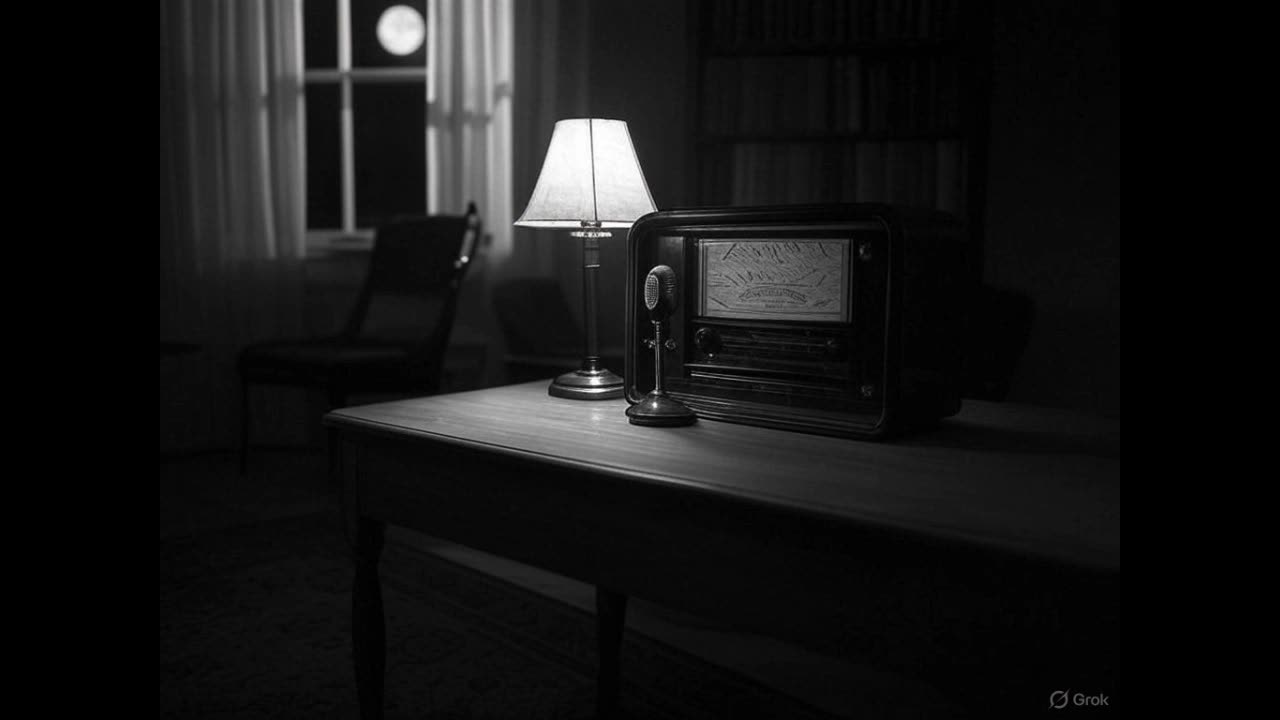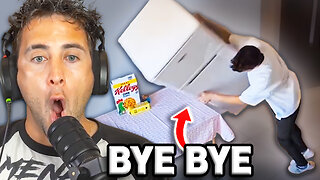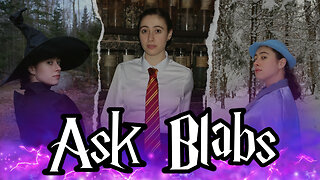Premium Only Content

Lights Out episode titled “Scoop” (December 8, 1942)
Episode: “Scoop” (December 8, 1942)
Cast and Roles
Arch Oboler as Host/Writer/Director: Oboler introduces the episode with his signature eerie line, “It… is… later… than… you… think,” setting a chilling tone. He likely provides narration or minor voice roles, as was common in the 1942–43 CBS revival.
Lead Actor(s) (Unknown, likely ensemble players): Lights Out typically used a small cast of versatile CBS radio actors from New York or Hollywood. The lead is likely a male character, possibly a journalist or newspaper reporter, given the title “Scoop,” which refers to an exclusive news story. A female co-star, perhaps a colleague, victim, or supernatural figure, adds emotional or narrative tension. Actors like Mercedes McCambridge, Lou Merrill, or Joseph Kearns, who appeared in other 1942 episodes, are possible but unconfirmed.
Supporting Actors: Additional voices for editors, sources, or supernatural entities, provided by actors doubling roles. The focus was on Oboler’s script and sound effects rather than star power.
CBS Sound Crew: Uncredited but essential, they created atmospheric effects like typewriters clacking, newsroom chatter, footsteps in dark alleys, or ghostly sounds, critical to the episode’s horror ambiance.
Note: Exact cast details are unavailable, as Lights Out rarely credited actors in surviving records, and this episode’s documentation is sparse. The 1942–43 run, sponsored by Ironized Yeast, relied on Oboler’s direction and CBS’s production quality, emphasizing sound and story over named performers.
Episode Summary
“Scoop” aired on CBS on December 8, 1942, as part of Arch Oboler’s 1942–43 Lights Out revival, broadcast at 8:00 p.m. ET in a prime-time, family-accessible slot. This 27-minute episode, available on the Internet Archive, is a supernatural horror tale likely centered on a journalist chasing a big story, only to encounter terror. While no detailed synopsis exists in public archives, the title and Oboler’s style allow for a plausible reconstruction:
Opening: Oboler begins with a tolling bell and his ominous warning, urging nervous listeners to turn off their radios. He introduces the story as a tale of ambition and the pursuit of truth, hinting at the dark consequences awaiting a reporter seeking a “scoop.”
Plot: The story likely follows a driven journalist, possibly a hard-boiled reporter in a gritty urban setting, determined to break an exclusive story. The “scoop” might involve a mysterious crime, a strange phenomenon, or a tip about a haunted location. As the reporter digs deeper, supernatural elements emerge—perhaps a ghostly informant, a cursed news tip, or a malevolent force tied to the story. Sound effects like clattering typewriters, ringing phones, or eerie whispers in dark streets heighten the tension. Oboler may explore themes of ambition, truth, or the cost of knowledge, with the journalist’s obsession leading to peril. A female character—possibly a fellow reporter, a source, or a victim—adds emotional stakes or serves as a warning voice.
Climax and Twist: Oboler’s stories often feature a shocking twist. The journalist might uncover a story that reveals his own death, or the “scoop” could be a trap set by a supernatural entity. Alternatively, the pursuit might lead to a nightmarish fate, such as being trapped in a ghostly newsroom or consumed by the story itself. The climax likely uses intense sound design—screams, distorted voices, or the sound of a printing press gone wild—to evoke terror.
Resolution: The episode probably concludes with Oboler’s narration, delivering a cryptic moral about the dangers of unchecked ambition or the limits of human understanding, followed by a jarring shift to a cheerful Ironized Yeast commercial, typical of radio’s tonal contrast. The story leaves listeners unsettled, pondering the price of chasing truth.
Tone and Style: The episode blends psychological horror with a journalistic setting, using Oboler’s stream-of-consciousness narration and vivid sound effects. It’s less gruesome than earlier Lights Out episodes, reflecting the prime-time slot, but eerie enough to captivate a broad audience, including families.
Note: Without a surviving transcript or detailed summary, the plot is inferred from the title “Scoop” and Oboler’s recurring motifs (e.g., ordinary professions turned sinister, supernatural consequences of human drives). If you’d like me to search for audio or fan discussions on X to refine the summary, let me know!
U.S. News on December 8, 1942
Based on historical records and news archives for December 8, 1942:
Pearl Harbor Anniversary: December 7 marked the first anniversary of the Pearl Harbor attack, and on December 8, U.S. newspapers like The New York Times and radio broadcasts reflected on the event, renewing calls for unity and sacrifice. Patriotic editorials and ceremonies dominated the news, reinforcing the war effort.
Gasoline Rationing Impact: Nationwide gasoline rationing, which began December 1, continued to shape daily life. On December 8, reports highlighted Americans adapting to limits of three gallons per week, with carpooling and public transit use rising. Shortages of coffee, sugar, and meat also persisted.
War Production Surge: The U.S. ramped up military production, with factories churning out planes, tanks, and ships. On December 8, news outlets reported record output, crediting women and minority workers filling labor gaps, a key home-front story.
Chicago Pile-1 Breakthrough: On December 2, Enrico Fermi’s team achieved the first controlled nuclear chain reaction at the University of Chicago, a secret milestone in the Manhattan Project. While not public on December 8, whispers of atomic research circulated in scientific circles, hinting at future impact.
These events underscored a nation fully mobilized for World War II, with radio shows like Lights Out offering a thrilling escape from war-related anxieties.
International News on December 8, 1942
Battle of Stalingrad: The Soviet Union’s counteroffensive (Operation Uranus) against German forces in Stalingrad gained momentum. On December 8, international dispatches reported the Red Army tightening its encirclement of the German Sixth Army, a pivotal moment in World War II.
North Africa Campaign: Allied forces advanced in Tunisia after Operation Torch and the Second Battle of El Alamein. On December 8, news highlighted U.S. and British troops clashing with German and Italian forces, with Tunis as a key objective.
Pacific Theater: The Guadalcanal Campaign saw continued Allied efforts to secure the Solomon Islands. On December 8, reports noted U.S. Marines repelling Japanese counterattacks, building on the Naval Battle of Guadalcanal’s success, signaling a shift in Pacific momentum.
Holocaust Awareness: In early December, Allied governments received detailed reports of Nazi death camps. On December 8, diplomatic channels discussed Jewish deportations, and the New York Times ran early stories on atrocities, though military news overshadowed them, delaying public focus.
These global stories reflected a world engulfed in war, with Lights Out providing a supernatural diversion from relentless battle reports.
Cultural Impact, If Any
The episode “Scoop” had limited direct cultural impact as a single broadcast in the 1942–43 Lights Out revival, but its context and themes contributed to broader cultural trends:
Journalistic Horror: The episode’s likely focus on a reporter chasing a dangerous story tapped into 1940s fascination with journalism, romanticized in films like His Girl Friday (1940). Its supernatural twist reflected wartime anxieties about truth and propaganda, as Americans relied on war correspondents for news, offering a chilling allegory for the risks of seeking knowledge.
Oboler’s Radio Legacy: Arch Oboler’s innovative use of sound effects and psychological horror in “Scoop” reinforced Lights Out’s status as a pioneer of radio drama. His techniques—clattering typewriters, eerie silences, and minimal casts—influenced later horror shows like Suspense and modern audio storytelling, including podcasts like The Black Tapes.
Wartime Escapism: Airing during World War II’s intense phase, the episode provided a thrilling distraction for families gathered around radios, especially poignant on the eve of Pearl Harbor’s anniversary. Its prime-time slot made horror accessible to a broader audience than the show’s earlier midnight runs, though toned down to suit families, aligning with radio’s role as a wartime morale booster.
Ephemeral Legacy: As a lesser-known episode, “Scoop” lacks the fame of Lights Out classics like “Cat Wife” or “Chicken Heart.” Its survival in archives ensures niche appeal among old-time radio fans, but it didn’t inspire specific adaptations or cultural references. Its significance lies in sustaining the series’ wartime relevance and horror innovation.
-
 36:53
36:53
daniellesmithab
3 days agoSupporting Alberta's Teachers and Students
893 -
 14:38
14:38
Nikko Ortiz
12 hours agoADHD vs Autism
4.99K11 -
 4:40
4:40
GritsGG
11 hours agoTwo Easter Eggs on Call of Duty Warzone!
2.48K -
 2:08:19
2:08:19
Side Scrollers Podcast
18 hours agoNetflix Execs to TESTIFY Over LGBTQ Agenda + IGN DESTROYS Xbox Game Pass + More | Side Scrollers
47.6K10 -
 5:08:55
5:08:55
Dr Disrespect
16 hours ago🔴LIVE - DR DISRESPECT - BABY STEPS - THE VERY VERY LAST CHAPTER
120K16 -
 10:28
10:28
BlabberingCollector
12 hours agoAsk Blabs, Episode 5 | Answering Your Wizarding World Related Questions
1.17K -
 18:09
18:09
Forrest Galante
5 days agoI Survived 24 Hours In The World's Deadliest Jungle
180K30 -
 LIVE
LIVE
Lofi Girl
2 years agoSynthwave Radio 🌌 - beats to chill/game to
212 watching -
 2:15:09
2:15:09
Badlands Media
16 hours agoOnlyLands Ep. 27: Power Hour Hangover, Trump’s Wartime Shift, and Portland in Flames
104K24 -
 22:21
22:21
DeVory Darkins
6 hours ago $14.96 earnedRioters attack Portland ICE Facility as Democrats make shocking admission
14.3K80
